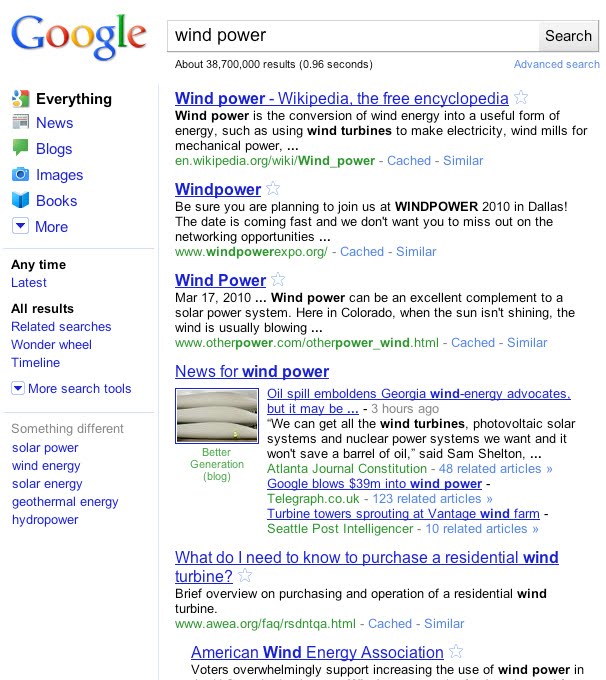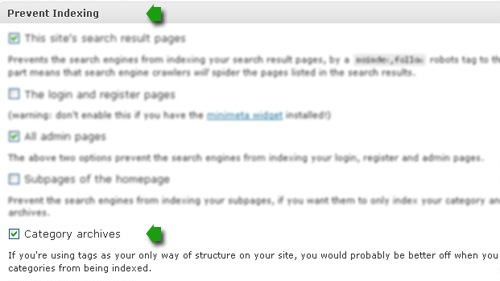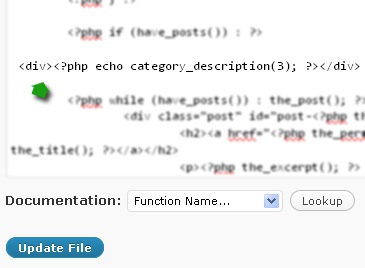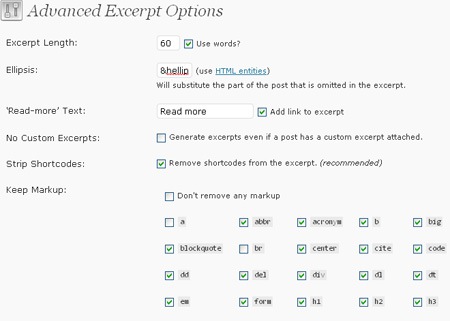"Search Engine Journal" - 6 new articles
- Google Gives its Search Results Pages the Bing Look
- 4 Easy Steps to SEO-Friendlier Blog Categories (Wordpress)
- Playing PPC Catch Up: Microsoft AdCenter
- Quick and Easy Ecommerce Site Optimization Tips
- Registered Trademarks and Other Symbols in the Title Tag
- Link Building Interview with Ontolo's Garrett French and Ben Wills
- More Recent Articles
- Search Search Engine Journal
Google Gives its Search Results Pages the Bing Look
Google has given its main web product, web search a much needed redesign. And while this is a welcome development since it's been quite awhile since Google has done this to its major service which happens to be the company's bread and butter, the new look of the search results pages will kind of remind you of Bing though. It's actually a simpler kind of Bing's search results pages.
Anyway, putting aside its similarities to Bing's search results pages, Google's redesigned search results pages now features a contextually relevant, left-hand navigation which highlights Google's search verticals including – news, blogs, images, books and more. The new side panel is powered by Google's search technologies – Universal Search, Search Options Panel and Google Squared.
What's good about the contents of the left-hand panel is that it is dynamic and changes depending on the type of your search. Through Universal Search technology, the items on the left-hand panel changes and suggests the most relevant genres of results for your query. And you can switch seamlessly to these different types of results. It could also suggest different views on how you want your search results to be displayed or even display the search results together with other related topics.In addition to the said enhancements to the search results interface, Google has also tweaked the color palette as well as the Google logo – giving the search results pages a modern and still simple look and feel.
The redesigned Google search interface is being rolled out globally today, although I haven't seen it when I tried visiting Google Search. Have you seen the changes already? How do you like the new design and navigation of the Google Search Results Pages?
Check out the SEO Tools guide at Search Engine Journal.
Google Gives its Search Results Pages the Bing Look
4 Easy Steps to SEO-Friendlier Blog Categories (Wordpress)
We all know which issues blog templates usually have with SEO – and one of the most wide-spread problems is a duplicate content one: blog home page, categories, tags and archives basically have same content.
This post looks at easy ways to eliminate the problem at blog category pages to make them SEO-friendlier.
Disable Indexing of Your Categories
(Warning: if you use this step, you don't need the rest of the post)
If you are sure that your category pages are not going to generate any search traffic for you, you may just exclude them from Google's index. One option is to use All-in-One SEO Pack for that.
However a much smarter plugin for that is Meta Robots WP plugin that allows to use noindex,follow robots meta tags for category pages to forbid indexing while allowing to follow the links to individual posts:
If you still want your category pages to be able to appear in search engine result pages, skip this one and proceed to the following steps:
1. Eliminate Duplicate Content
The hugest issue with your categories is that they don't have unique content. We'll change that though:
1. Display category descriptions:
Most people are aware of the fact that there's a handy extra field at your category editor page called "Description". Few people use it to the full potential though.
By default, the category description is shown when you hover over the category link in the sidebar widget. To display it on your individual category page you will need to use the following code:
Now, if you need any HTML in there, take advantage of this plugin: it doesn't have a visual editor but it lets you insert any HTML in your category description.
2. Work on the list of posts
You want to make the category pages lightweight and as unique as possible. For that you need to either:
- Strip the post extract and only display the list of post headings; OR
- Display excerpts of the page (to strip images, formatting, links, etc).
For the first option you will just need to go to the theme editor and remove
part that follows each page title.
And for the second option you will need to change that for:
Now, if you need to modify which type of HTML tags you want to strip in your excerpts, use this plugin that:
- Keeps HTML markup in the excerpt (and you get to choose which tags are included)
- Trims the excerpt to a given length using either character count or word count
3. Optimize Paging Structure
Wordpress SEO Pager plugin implements a multi-page customizable pager to replace the standard, boring WordPress "Earlier Posts" and "Newer Posts" links. This improves SEO as well as usability.
- Add page numbers to category and archive listing page titles.
- Optionally excerpt posts on page numbers greater than 1.
- Let the search bot easier access deeper pages:
4. Interlink your categories
Yes, your categories are already linked to sitewide from your blog sidebar. However you should also link to them organically from the post content as well as vary the internal anchor text:
- Use this method I described earlier to smartly interlink your blog pages automatically;
- Vary anchor text using one of these plugins that allow some more advanced tools to interlink your blog content.
Any other tips to optimize your blog categories? Let me know in the comments!
Check out the SEO Tools guide at Search Engine Journal.
4 Easy Steps to SEO-Friendlier Blog Categories (Wordpress)

Playing PPC Catch Up: Microsoft AdCenter
Taking a look at the history of PPC and comparing it with today's market, you can see the complete 180 that the space has taken. Starting with Goto, to Overture, and into today's platforms. Things have changed, and I'm not just talking about the bidding system. The top players have completely changed, and the MSN/Yahoo partnership has the potential to force change yet again.
First off, I'm not a huge fan of the MSN/Yahoo "partnership." Or I wasn't a fan. What can I say, I'm an "oldie" when it comes to PPC. Yahoo is the oldest in the market, PPC and Search actually, and it just seems like they are lying down.
What I am seeing about the merger partnership that is positive is the move to take the Yahoo PPC program and move it into the AdCenter platform. I see this as a positive because the Panama change was just horrible in so many ways. On the other hand, AdCenter has been working very hard to get their offering up to par with industry leader Google AdWords.
Here are some things I've seen change and LOVE:
- AdCenter Desktop Editor – My only qualm here is that this is only for PC (come ON Microsoft, stop it, we are computer users too, and no this is not making me want to buy a PC).
- Client/Agency Relationships – You can now add someone as an "agency" and either side can terminate the relationship when it is no longer active. You are no longer bound to an agencies master account.
- Search Query Performance Report – AdCenter followed Google's lead here, and it's my favorite report ever. Thank you!
- AdCenter Blog – I love the people at MSN AdCenter. They keep giving awesome tips for advertisers. Subscribe. Trust me.
Areas I can still see for improvement:
- Support Your Competitors Products – They aren't your competitors when it comes to your advertising. Get over it, k?
- Mac Support for Excel Plugin and Desktop Editor (while you're at it can you tell the Excel people to make Excel Mac like Excel PC? Thanx.)
- Google Chrome Support (it works, but can we remove the warning?)
- Import Function from and to Google AdWords – Meeting of the minds. You can haz it. Go into your own account with AdWords and find a fix. Hey AdWords, you do the same, k?
- Loading Time on the Web Interface – Things are just slow. Sorry, it makes it hard to work in the web interface still. The new Navigation tab is there, yes, but it's still too slow.
- Change Match Types – There is no easy way to change keyword match types. Small but very important in the web interface.
Overall I am pleased as punch with the way things are going over there. I think they are a little bogged down with the transition right now, but I can't wait to see what is coming from them in the second half of the year. Hold onto your hats, I think they are setting up to give AdWords a run for its money. If you haven't tested the platform recently, give it a spin. The traffic is still low, but with the merger partnership with Yahoo, things might improve soon.
Check out the SEO Tools guide at Search Engine Journal.
Playing PPC Catch Up: Microsoft AdCenter
Quick and Easy Ecommerce Site Optimization Tips
How best to deal with pagination in ecommerce sites is a topic that is often discussed by SEOs. Here I shall outline a technique that I have successfully used in the onsite SEO of various ecommerce websites.
Typically these sites present many hundreds or thousands of products sub-divided into categories, sub-categories and in some cases sub-sub-categories. Each of the categories and sub-categories is presented using many paginated pages and the visitor is provided with controls enabling them to view products based upon price, availability and various other attributes. Each of these different views and each paginated page of products use unique URLs, but the introductory copy is common to all pages and views within the category or sub-category.
Bring Focus to Pages of Importance
This type of ecommerce site implementation is not uncommon. It presents a number of issues including the significant onsite duplication of the content provided on the category or sub-category landing pages. My quick and easy approach has been to bring focus to the key category and sub-category landing pages by:
a) No-indexing all paginated pages using: in the head section of each page and
b) Introducing the canonical tag to all paginated pages, indicating the parent category or sub-category page and the canonical
version using: .The effect of this simple change was swift and dramatic. By no-indexing the paginated pages Google was no longer required to crawl and index pages that present largely the same content as other pages in the same category. This brought immediate focus to these important landing pages for the keyterms used in the descriptive category copy, which was no longer duplicated.
You will notice that, although the paginated pages were no-indexed they were not no-followed. This means that the linked product detail pages, which are all unique, are still visited by the crawlers and this improved the indexation of these pages.
Additional Onsite SEO Enhancement
Further SEO improvements were achieved through identifying keyterm themes relevant to each category then prioritizing the various keyterms and ensuring they were used appropriately in the page titles and content. In some cases I've also introduced dynamic elements that bring fresh, relevant content to each of the key, category landing pages.
I've also got into the habit of introducing dynamic, segmented sitemap systems that present fewer than 100 links per sitemap page, dynamically built from the product database. These have contributed to improved positions and greater traffic for a great many long tail queries.
The result of these fairly modest onsite changes has been a massive increase in traffic arriving from the organic SERPs as a result of both generic and long tail searches, due to significantly higher rankings for various terms. Also, the relevant category pages are those which are returned in the SERPs and visitors are now entering the site through category pages that are most relevant to their queries. Visitors are therefore finding what they were looking for and my clients are selling more products so everyone is happy.
Check out the SEO Tools guide at Search Engine Journal.
Quick and Easy Ecommerce Site Optimization Tips
Registered Trademarks and Other Symbols in the Title Tag
Take a moment and pretend you're a search engine bot –
It's early in the morning. You are enjoying a fresh cup of coffee while reading the latest sitemap. (Yes, drinking coffee. Google Caffeine – a greater quantity of search results in less time; this is pretend, it is clearly the obvious answer.) Once the caffeine kicks in you find yourself cursing though all the readable content, jumping from page to page, making notes on everything you see. You pass over a registered trademark symbol in the title tag and other key areas of readable content – Do you make a special note to assign extra weight for search rankings?
I was recently wondering about what effects registered trademarks (or other similar symbols) located in the title tag and other places of your website might have on search rankings. Registered trademarks are the symbol of ownership for a product or brand name. Might they have some sort of magical effect on SEO and search results, especially in key areas of web pages such as title tags?
Not sure of the answer, I went ahead and did some digging. Of the few posts and discussion forums I did manage to unearth, while they do seem relevant, I must warn I would not exactly label them fresh. Dates go as far back as 2003. Nevertheless, I would like to get to the bottom of trademarks and other symbols and SEO, so here is what I found:
- How do you get a registered trade mark or other symbols into the title tag?
Just like when inserting a registered trade mark symbol into the body of a website, html code is inserted into the title tag to display the special characters not on your keyboard. (Ex. ®)
- Does having a registered trademark or other symbols in your title tag help rankings?
TDTECHFLEX, a anonymous contributor to the ihelpyou forum, put it best when posting on this thread:
"I doubt that Google or Yahoo would see the tm and think "oh, this must be THE authority" since anyone could use such for an off-white tactic. I do think that human users might pay more attention to a title with it."
I would have to agree with this comment; one probably should not expect to be rewarded by search engines for simply inserting a registered trademark symbol into the title tag. Rather, end users are likely going pay more attention to a title tag with it – translating into a higher click-through rate for the total number of impressions your site generates.
- How do Google and other search engines interpret the html code found in title tags?
One of the few excerpts I found addressing this question was found within this old Google Answers post (take this with a grain of salt, it dates back to 2003):
"Additionally, using the Registered Trademark symbol may actually be diluting the keyword relevancy. The symbol is counted as a separate word in the title.
Compare www.microsoft.com. Microsoft is well-known for aggressive use of their Registered Trademark, yet it does not appear in the title of their web pages."
So not only are registered trademark symbols not believed to directly increase rankings, they may in fact do the opposite, diluting keyword relevancy. Intuitively it makes sense, how many people do you know use HTML code for ANY particular symbol in a search query?
Say you are trying to optimize for a particular keyword phrase in the title tag that contains a brand or product name with a registered trademark you cannot ignore – How do you balance the two?
Key points to be mindful of when using registered trademarks:
Larre -GA of Google Answers Recommends:
Double Keyword Density and Enhance "Findability" – Format your title tag to use both the registered trademark brand or product name along with the SEO keyword phrase of focus. (Keep in mind Google will display up to 66 characters of a title tag) For example: Brand/Product Name ® – Keyword phrase (Brand/Product name w/o symbol)
- Spacing is Key – Assuming a symbol is viewed as a separate word in a keyword phrase when using the symbol, be sure to insert a space between the brand or product name and the actual symbol.
Last but not least, ListPipe Blog recommends:
- Avoid Overuse – Once legal ownership is established, it is unnecessary to include a trademark symbol with every instance of a term. Not only is overuse of a symbol cumbersome to readers, but it limits the relevancy between your posted content and the actual terms people are using to search for your site.
Anyone else know of any more recent sources, maybe with a little more authority speaking on the topic?
Check out the SEO Tools guide at Search Engine Journal.
Registered Trademarks and Other Symbols in the Title Tag
Link Building Interview with Ontolo's Garrett French and Ben Wills
April 27th 2010 marked the launch of Ontolo's Link Building Toolset, in the works since 2008. The Link Building Toolset uses targeted SEO keywords to find and grade link prospects, saving link builders 80% of the time typically spent on prospecting and qualification. This interview with the creators, Garrett French and Ben Wills, traces their roots in the SEO space and offers some great link building advice!
1) What's the hardest part of link building for you guys?
Garrett: Creating great content remains one of the hardest parts of link building for me, whether I'm writing ABOUT link building or a clients' subject area. It's tough on one level simply because for me content creation involves massive amounts of learning, research, interviews and then finally I get down to writing. And the second level of difficulty comes in actually doing the outreach required to earn the links from the prospects. Even in the link building content space I still have tough time determining whether or not a given topic will be a base hit or a grand slam. This is why on the content side we've been leaning more towards expert engagement (eg: group interviews with bloggers) since the contributing experts have incentive to mention their involvement.
Ben: Garrett's on the creative side of link building and I'm on the programatic/analytical/scalable side. The toughest part of link building for me (which is also the part that I enjoy the most) is breaking down human assessments into programatic assessments. An example of this is our "Potentiality" score, which determines the likelihood that a URL will actually link out to another website. Most people would say that this kind of analysis can only be done by a person. While I agree that every URL needs a human review to be 100% certain to approach it, that potentiality score sure cuts down on manual qualification times for us.
2) So can you tell us a bit more about expert engagement?
Garrett: For me it's an extension of the discovery I made at WPN – readers like expert answers, experts like exposure and recognition. For the engagement-focused link builder this involves identifying the recognized experts and/or celebrities within a keyword space and then asking them great questions either as a group or individually. The quality of your questions, the topic of your questions and your brand's existing influence in your keyword space will all impact on how well this works for you.
Ben: I really enjoy three main things about engaging experts for content and link building:
1, The quality of ideation and brainstorming is unmatched. For an idea guy like myself, I love this.
2, When you're working with known experts, when done in a certain way, there's a specific kind of social/expert value that's also transferred to you. Now, this doesn't *make* you an expert, but if you're recurrently working with experts…
3, In terms of producing content for a market space, aside from some of the fringe stuff out there, this can be some of the most useful content for learning an industry. It's how I started, reading top blogs, forums, etc.
3) How did you guys get involved in link building?
Garrett French: My start in link building really began back in my WebProNews days (2001-2004). That's when I gave links to SEO experts in exchange for their answers to my readers' questions. The answers helped my readers rank better, and the expert access helped WPN's brand.
The links helped the experts' rankings, and the exposure to my readers built referrals and leads. Their answers helped me because they reduced my writing load for the day ;) This is when I really began thinking about how content enables marketers to reach their target audience, and laid the ground work for my content-based link building approach. I met Ben when I moved to RTP to join Andy Beal at WebSourced. After leaving that company I wrote and built links freelance for a couple years and then started working with Ben to help him hone and launch the Ontolo Link Building Toolset.
Ben Wills: I got involved in SEO in 2001, working for what would become the largest SEO company in the world, KeywordRanking/WebSourced. It was my responsibility there to design our services that would then get implemented by each of the client teams.
Every time we asked a client what they wanted more of, it was always link building. The solution we have today at Ontolo actually started from some ideation that occurred (but was never implemented) during those days. When I worked with Andy Beal at Fortune Interactive, we heard the same thing and, for various reasons, never implemented a solid link building solution. After manually reviewing tens of thousands of link prospects and a year and a half into consulting independently – July of 2008 – I decided it was time to really take a crack at link building, which is where Ontolo was born from.
4) What can you tell us about your new tool?
Garrett: Well, simply put, it's amazing ;) For me it's a dream come true in that it's beautifully designed to provide link builders with a steady stream of link prospects based on their linkable assets. This is where I often hit a road block with competitor backlinks… It's great to know that site A linked to competitor B, but we don't have any idea of their intent (something Eric Ward focuses on a great deal).
Our tool is well suited for connecting linkable assets with link prospects that are more likely to have an interest in linking. It's also provides a keyword-searchable interface for digging through link prospects which comes in handy when I've got a new piece of content that I'm ready to promote.
Ben: Our number one goal is this: To help you find more link prospects and more valuable link prospects, faster. Our toolset focuses strictly on this. As Garrett mentioned, this moves well beyond (and compliments) backlink analysis. This looks at your entire market and the link opportunities that exist there from links pages and directory pages all the way to blog partners, guest posts and guest publishing opportunities.
Once we identify those opportunities by discovering, indexing and crawling tens of thousands of link prospects per month for you, we also then give you the toolset necessary to wade through the prospects as quickly as possible. Then, behind the scenes, we offer exclusive tutorials, content, and training to help you use the data set as quickly and efficiently as possible so that you can spend more time building high-quality relationships, and less time wading through spreadsheets of prospects.
5) How is the Link Building Toolset different from MajesticSEO and LinkScape?
Garrett: Based on your target keywords, we find and grade a steady stream of link prospects and add them to your searchable database. MajesticSEO and LinkScape provide and grade competitor backlinks. It's sort of like the difference between a search engine and a directory ;) We see them as highly complimentary sources for link prospects – we're looking outside the existing competitor link graph, while they're looking directly at it.
Ben: The main difference is that we are text-based, not backlink based. Where Majestic and LinkScape are restricted to backlinks to a specific URL (which certainly has its uses), we look at an entire industry based on *keywords*, then give you tools to search the full text of each link prospect, rather than just link relationships. This lets you look at 100,000 URLs and find *only* the guest post opportunities in a matter of seconds, rather than having to dig through and manually review tens of thousands of URLs for what *might* be a guest post opportunity.
Check out the SEO Tools guide at Search Engine Journal.
Link Building Interview with Ontolo's Garrett French and Ben Wills
More Recent Articles

Click here to safely unsubscribe now from "Search Engine Journal" or change your subscription or subscribe
Unsubscribe from all current and future newsletters powered by FeedBlitz
Your requested content delivery powered by FeedBlitz, LLC, 9 Thoreau Way, Sudbury, MA 01776, USA. +1.978.776.9498
viernes, 7 de mayo de 2010
Search Engine Journal - 6 new articles
Suscribirse a:
Enviar comentarios (Atom)
Seguidores
Archivo del blog
-
▼
2010
(127)
- ► septiembre (7)
-
▼
mayo
(20)
- 6 new articles
- 2 new articles
- 6 new articles
- 4 new articles
- new articles
- 7 new articles
- 5 new articles
- 4 new articles
- 7 new articles
- 4 new articles
- Search Engine Journal - 5 new articles
- 5 new articles
- 4 new articles
- 2 new articles
- Search Engine Journal - 6 new articles
- 3 new articles
- <!-- AOL_MESSAGE --><!-- Your FeedBlitz Updates ...
- <!-- AOL_MESSAGE --><!-- Your FeedBlitz Updates ...
- <!-- AOL_MESSAGE --><!-- Your FeedBlitz Updates ...
- <!-- AOL_MESSAGE --><!-- Your FeedBlitz Updates ...







No hay comentarios:
Publicar un comentario